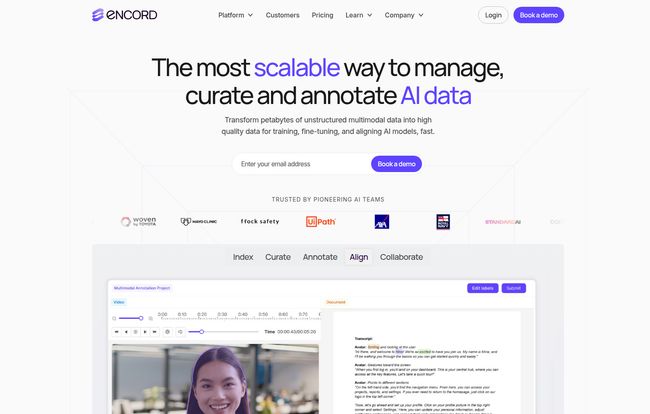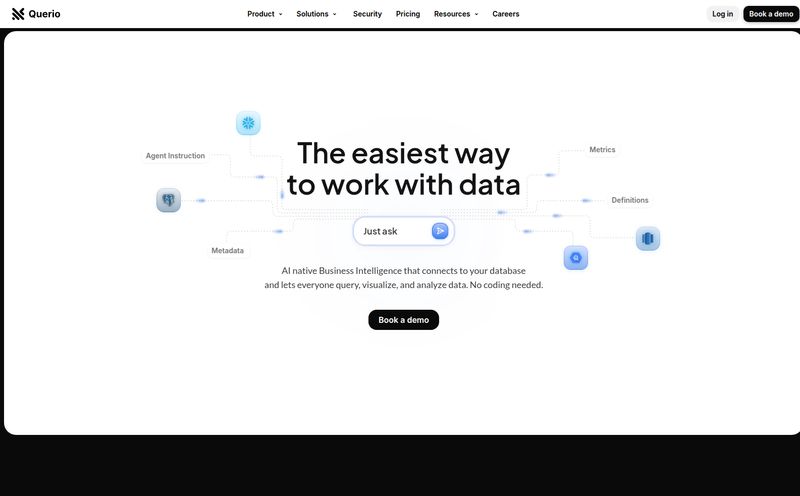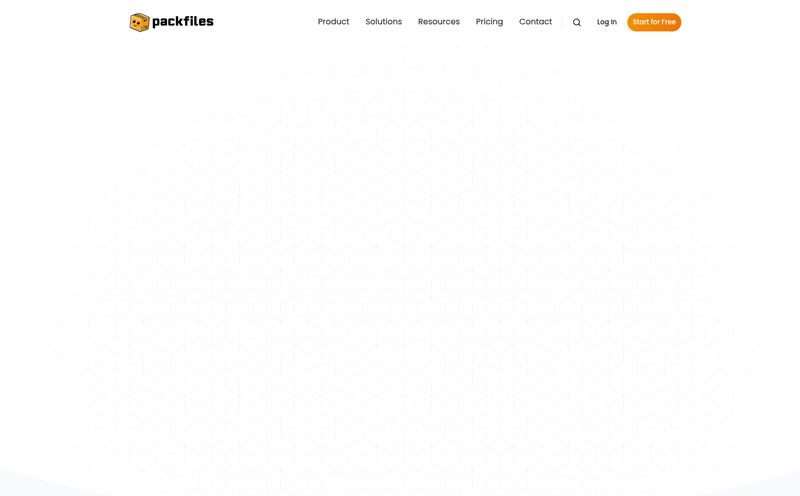If you've spent any time in the trenches of applied AI, you know the truth. The sexy part is the model—the clever architecture, the training loops, the triumphant moment when `accuracy: 99%` prints to your console. But the real work? The unglamorous, back-breaking, make-or-break work? It's all about the data.
We've all been there. Juggling CSVs, a clunky open-source annotation tool, a separate bucket for 'good' data, another for 'needs review', and a mountain of Python scripts held together with duct tape and hope to actually evaluate anything. It’s a mess. Data isn't the new oil; for many of us, it's the new swamp. A murky, disorganized bog that swallows time and energy. And that's precisely the problem platforms like Encord are trying to solve.
I’ve been watching the MLOps space for years, and I've seen a dozen tools that claim to be the 'one platform to rule them all.' Most aren't. But Encord... Encord caught my eye because they aren’t just talking about labeling. They’re talking about the entire data lifecycle. So, I decided to take a proper look, and here's what I found.
The Vicious Cycle of AI Data (And How Encord Tries to Break It)
The core concept behind data-centric AI, a term popularized by folks like Andrej Karpathy, is simple: stop obsessing over tweaking your model and start obsessing over improving your data. Garbage in, garbage out. It’s the oldest rule in the book.
The problem is that our tooling has historically been fragmented. You might use Labelbox for annotation, AWS S3 for storage, and a custom evaluation harness for testing. Each step is a silo. Moving data between them is a pain, ensuring quality is a nightmare, and finding subtle biases or edge cases is like looking for a specific needle in a continent of haystacks.
Encord’s big pitch is that it offers a “unified data layer for AI development.” Marketing speak? A little. But the idea is powerful. What if the place you label your data is also the place you curate it, search it, version it, and use it to evaluate your model's performance? That’s the goal. A single source of truth for your data.
A Look Under the Hood of Encord
So what does this unified platform actually do? I see it as three main pillars.
More Than Just a Labeling Tool
First, yes, Encord is an annotation platform. And it's a slick one. It handles all the usual suspects: bounding boxes, polygons, polylines, keypoints. But it goes further, supporting complex and specialized data types. We're talking video annotation, which is a beast on its own, but also native support for DICOM and NIfTI files. If you're in medical AI, you know how huge that is. No more converting everything to PNGs and losing critical metadata.
The workflow tools also seem pretty solid, allowing you to build multi-stage labeling pipelines with review and sign-off steps. Standard stuff for a serious tool, but executed cleanly.

Visit Encord
The “Active” Part: Curation and Quality Control
This is where things get interesting for me. Just having a pile of labeled data isn't enough. You need to know what's in it. Encord's platform lets you index and search your data—not just by filename, but by metadata, label content, and even model predictions. Need to find all images with 'small, occluded pedestrians' that your last model run missed? You can supposedly do that here.
They call this part of the suite “Active,” which includes tools for intelligently surfacing data for labeling (active learning), finding labeling errors, and managing data quality. This moves beyond just being a passive data bucket and turns your dataset into a queryable, improvable asset. That's a big shift in mindset.
Closing the Loop with Model Evaluation
Here’s the kicker. You can import your model's predictions back into Encord and compare them directly against your ground truth labels. This closes the loop. You can see, visually and quantitatively, where your model is failing. You can debug your model’s performance not in a terminal with abstract metrics, but on the very data it’s struggling with. Then you can send that data right back into the annotation queue to be fixed or augmented.
This tight integration between data, labels, and model outputs is the holy grail for a lot of teams. It's the difference between flying blind and having a proper instrument panel.
The Eternal Question: Build vs. Buy?
I can hear the senior engineers on my team already: “We can build that ourselves.” And you know what? They’re probably right. You can build a basic annotation tool. You can write scripts to manage S3 buckets. You can cobble together an evaluation framework with Matplotlib.
Encord puts a number on this on their website, suggesting an in-house solution costs upwards of $300,000 in development and has high ongoing maintenance. That figure might be a bit of marketing flair, but the sentiment is dead on. The real cost of a home-grown system isn't the initial build; it’s the endless maintenance, the feature requests from the data science team, the security patches, the constant firefighting. It's an engineering rabbit hole that distracts you from your actual goal: building better models.
In my experience, unless building MLOps tooling is your company’s core business, you should almost always buy. Your engineers' time is better spent on the unique problems of your domain.
Let's Talk Money: Breaking Down Encord's Pricing
Okay, so how much does this unified dream cost? Encord uses a fairly standard three-tier SaaS model. It’s worth looking at because it tells you who they're targeting.
| Plan | Best For | Key Features | Price |
|---|---|---|---|
| Starter | Individuals & Academics | Up to 5 users, basic annotation, image & video support. | Free |
| Team | Growing Production Teams | API & SDK access, DICOM support, up to 1M data assets, SSO. | Custom |
| Enterprise | Large-Scale Deployments | All features, on-prem option, multiple workspaces, custom SLA. | Custom |
The Starter plan is genuinely free, which is awesome. It's perfect for a PhD student, a small research group, or a developer wanting to kick the tires and see if the platform clicks. The limitations (no API, limited assets) are reasonable.
The Team and Enterprise tiers are where the real power lies, with API access, advanced data types, and scalability. And yes, they have the dreaded “Contact Us” for pricing. I know, I know, it's annoying. But for enterprise-grade software with variable needs (data volume, support levels, on-prem vs cloud), it's pretty much the industry standard. Expect it to be a significant investment, priced per seat or by data volume, likely in the thousands or tens of thousands per year depending on your scale.
The Good, The Bad, and The Platform-y
No tool is perfect. After digging in, here’s my balanced take.
The biggest advantage is the all-in-one nature of the platform. The seamless flow from labeling to curation to evaluation is its superpower. It’s designed to break down the silos that slow teams down. The support for specialized data like DICOM is also a massive win for anyone in a technical field like healthcare AI.
On the flip side, a platform this comprehensive will inevitably have a learning curve. This isn’t a tool you’ll master in an afternoon. To get the most out of it, your team will need to invest time in learning its workflows and features. The pricing for the paid tiers will also be a barrier for early-stage startups or smaller teams without significant funding. And finally, there's the vendor lock-in question. By building your entire data workflow on Encord, you are tying yourself to their ecosystem. It's a trade-off: you gain immense convenience and power, but lose some flexibility. That's a strategic decision every team has to make for themselves.
So, Who Is This Actually For?
Encord is not for the casual hobbyist. It's for serious, professional AI teams who are feeling the growing pains of a fragmented data infrastructure. I'm thinking of teams in autonomous driving, medical imaging, agritech, robotics, and quality assurance.
"Encord brought together scalability, video, and medical data support, and workflow flexibility to support other modalities in a single, unified platform."
- Nick Gidmark, Head of AI/ML, Memorial Sloan Kettering Cancer Center
When you see names like Memorial Sloan Kettering, Tractable, and Capdoto using a tool, it tells you something. These are organizations dealing with complex, high-stakes AI problems. If your team spends more time managing data than building models, you're probably the target audience.
Frequently Asked Questions about Encord
What is Encord best used for?
Encord is best for computer vision teams that need a single, unified platform to manage the entire data lifecycle. This includes complex data annotation (especially for video and medical imaging like DICOM), data curation, quality control, and model performance evaluation.
Is Encord free to use?
Yes, Encord has a free 'Starter' plan designed for individuals and academic researchers. It includes core annotation features for up to 5 users but has limitations on data volume and advanced features like API access.
What kinds of data can Encord handle?
Encord supports a wide range of data modalities. This includes standard images and videos, but its main differentiators are native support for DICOM and NIfTI for medical imaging, as well as SAR data for satellite and aerial imagery analysis.
How does Encord help improve model performance?
It helps by focusing on the data. Encord allows you to find and fix labeling errors, intelligently select data for annotation (active learning), and most importantly, import your model's predictions to directly compare them against ground truth. This helps you quickly identify and address your model's weaknesses.
Does Encord integrate with other machine learning tools?
Yes, it's designed to fit into an existing MLOps stack. The website shows integrations with major cloud providers (AWS, GCP, Azure) and popular ML frameworks and tools like PyTorch and Weights & Biases.
Is Encord difficult to learn?
Because it's a comprehensive platform with many features, there will be a learning curve. While the basic annotation UI is intuitive, mastering the data curation, workflow management, and model evaluation features will take some time and effort from your team.
Final Thoughts
Look, the MLOps landscape is crowded. But Encord feels different. It's not just another annotation tool with a few extra bells and whistles. It's a thoughtfully designed, end-to-end data engine that tackles the least sexy, but most important, part of building production AI.
It's not for everyone, and it's not a magic bullet. You still need a smart team to make smart decisions. But it gives that team a much, much better control panel. If you're tired of fighting the data swamp and want to spend more time building models that work in the real world, I think Encord is absolutely worth a serious look. It might just be the unified platform you've been waiting for.
Reference and Sources
- Encord Official Website
- Encord Pricing Page
- Andrej Karpathy's Blog (for discussion on data-centric AI)



